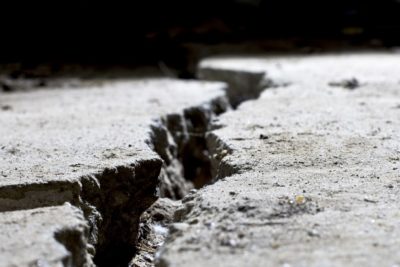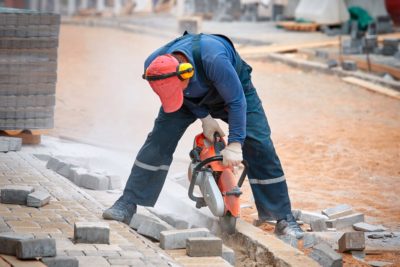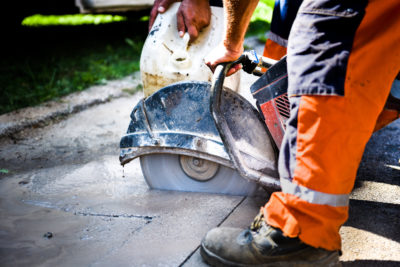In a lot of construction and renovation work, you’re going to need to saw some concrete. Here’s the lowdown. Concrete sawing is a tricky job unless you know what you’re doing and you’ve got the right gear. In this piece we look at what’s involved both beforehand and during the operation, and, if it all looks a bit too tricky, what professional concrete cutters Perth offers.
What Do You Need to Prepare for Your Concrete Cutting Job?
First of all, assess the job. If it’s going to involve a cut through a thickness of over six inches, you’re probably better off calling in the experts. Luckily, up to six inches covers most applications, so for all but the biggest jobs, you’ll be able to do this with the right equipment and preparation.
Equipment
Assuming you’re not going down the chisel and hammer route (only advisable for very small jobs) there’s one item you need above all else, and that’s a diamond blade saw.
Some make the mistake of using an abrasive saw to cut concrete rather than a saw with diamond cutting blades. Don’t join them. It’ll quickly wear out and you might find yourself having to force the cut, which is dangerous.
The saw can be a dry cutting one or, for bigger jobs, a wet cutting model. The former works with a handheld or circular saw, and is good for shallower cuts. The latter is often used with a walk-behind unit that you can get your hands on from a rental outlet. This is good for when you have to go deep.
If you’re not using a walk-behind, you’ll need to get hold of a sledgehammer to do the actual breaking.
Indispensible safety gear includes the following. A filtration mask to protect your lungs from the dust clouds that your sawing will generate. Protective goggles will guard against foreign bodies getting into your eyes. Kneepads and shinguards to protect your legs against the hard surfaces they’ll be thrust against. Steel Toe boots will help you retain your full complement of toes. A ground fault circuit interrupter (GFCI) will protect you and the equipment from surges and shocks.
Preparation
Give your environment a recce. Eradicate any trip hazards. Then go around making sure that no dust can enter your home. This involves installing drop cloths over your doors and ensuring that the windows are closed if you’re working in the garden. Look out for air intake units and make sure you cover them well.
It’s important to be sure that you have an accurate idea of the territory you’re cutting in. Which leads us to an important prep step: scanning.
What are the Benefits of Scanning Before You Cut?
Concrete scanning is a procedure whereby tests allow the operative to see beneath the surface to assess exactly what’s going on down there. This can be in terms of any hidden objects immersed in the concrete or any anomalies in the concrete structure. The test results are given in 3D arrays in real time, minimising site delays.
The key benefit to a concrete scan is this: you’ll find out about potential dangers and complications before you go sawing through them. Dangers can include power lines or steel reinforcement bars. Go through those and you’ll know about it. As will, possibly, the whole street. It’s always best to know about these elements ahead of time so you can avoid all danger to yourself and others.
Complications might include variations in the concrete structure, such as air pockets or changes due to erosion. It’s good to be prepared for these, as they can result in changes being needed in the equipment settings.
At worst, they can result in more danger, for instance slab scanning can reveal where the load-bearing capacity of the concrete has been compromised. Again, you want to know about this before you get busy with your walk-behind behemoth.
So scanning concrete gives you the heads up you need to ensure a safer and more straightforward operation. And this in turn means a tighter timetable can be observed, as well as restricting unforeseen expenditure.
What’s the Concrete Cutting Process? How Do You Precisely Cut Concrete?
So, you’ve got your gear and you’ve done your preparation. Now it comes to the cut. How do you cut concrete without cracking it? Here’s how.
Start by marking out where the cut’s going to take place, ideally in thick chalk. Perform a PPE check to ensure you’ve got full protection. Try to apply water to the cut (even with a dry saw), perhaps via a garden hose in the hands of a willing accomplice, to try to minimise dust and promote cooling. Then position a guide board along the chalk line. You’re almost ready to cut.
How deep should a concrete saw cut be? The answer is to start small and build up gradually. With the saw definitely off, set the blade depth to a half-inch. By cutting in shallow increments you can maximise control. (If you’re using a walk-behind, you can just go all out. Within reason.)
Power up to the lowest RPM setting and, with both hands on the saw, run it along the side of the guide board. Don’t force it – just allow the blade to make the cut, for a duration of no more than 45 seconds. Then remove the saw and allow it to spin freely for a short while (this frees up any debris and affords some cooling). Then resume the cutting line.
When you reach the end of the line, remove the guide board and run the saw along the line again. Then, obviously with the saw off, raise the blade depth by half an inch and repeat the whole procedure, until you have a depth you’re happy with. Take regular breaks, if only to clear out the dust that will cover the place in no time at all.
Once you’ve reached the required depth, it’s time to bring on the sledgehammer. With your PPE still on, use the hammer to hit not quite on the cut line but just to the side of it (on the portion of concrete that’s to be jettisoned). Once the break opens up, you’ll need to tidy up the cut with a chisel. Then take the newly created pile of concrete chunks to a disposal facility.
Who can help with your concrete cutting?
So, you’ve asked yourself the question should I saw cut my concrete? You’ve decided it looks like the job might be best in the hands of the professionals. There’s no shame in that. Many are the gung ho amateurs that only wish they’d applied the same sensible appraisal prior to beginning work on their now devastated patio.
Happily, when it comes to concrete cutting Perth can boast a professional crew who can take care of your job with a minimum of fuss and disturbance. So, if you’re in Perth concrete cutting can be left in the hands of the experts. Fill in an enquiry form today and let Diamond Cut Concrete take care of all your saw points.



